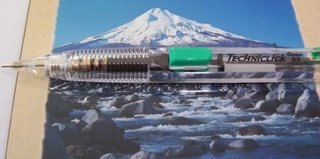The Pentel Techniclick comes in a small selection of colours and 0.5 or 0.7mm lead thicknesses. There are also another couple of Techniclick variants with different grips etc but they are separate pencils in their own right, so are not discussed any further here. My Techniclick is the green 0.5mm model, PD105T.
 The body is clear plastic with a tinted end section. It is round in cross section with a flattened area on one side where the “clicker button” is. The clear plastic has good optical clarity, without flow lines or flaws, exactly the sort of quality moulding you would expect from Pentel. These guys really do know a thing or two about injection moulding.
The body is clear plastic with a tinted end section. It is round in cross section with a flattened area on one side where the “clicker button” is. The clear plastic has good optical clarity, without flow lines or flaws, exactly the sort of quality moulding you would expect from Pentel. These guys really do know a thing or two about injection moulding.The tinted top section pulls off to get at the eraser, and to refill the lead chamber. I am a little dubious about how long the friction fit of the top section onto the body will last as it will get a lot of use over time. The pocket clip is part of the top section, and one of the better plastic moulded clips around. Being a separate section has allowed them to get some extra clip pressure onto the main body. The eraser is the standard mid-size Pentel rubber eraser.
 With that side clicker button this is obviously a button ratchet mechanism. As expected the button uses angled wedges to activate the lead advance mechanism. Now I am not generally a fan of side button pencils. In this case the button is fairly small and conveniently positioned for fast easy activation while writing, but when I’m just idly holding the pencil in my hand, the buttons right there under my fingers, just asking to be pushed. (Mmmmm button - must push!) The button has a good firm but easy action to it.
With that side clicker button this is obviously a button ratchet mechanism. As expected the button uses angled wedges to activate the lead advance mechanism. Now I am not generally a fan of side button pencils. In this case the button is fairly small and conveniently positioned for fast easy activation while writing, but when I’m just idly holding the pencil in my hand, the buttons right there under my fingers, just asking to be pushed. (Mmmmm button - must push!) The button has a good firm but easy action to it.There is a 3mm metal lead sleeve so this pencil is suitable for draughting, but it’s not retractable for pocket safety. The grip section is a series of smooth shallow ribs, reasonably effective and comfortable.
Like most, but not all Pentels, this one is made in Japan. The barcode label on the body peeled off easily in one go and didn’t leave any of that annoying sticky residue behind. More evidence of Pentels attention to detail. Overall a good economy price range mechanical pencil.
- Best Points – Good plastic pocket clip and interesting optical effects as you rotate the pencil around.
- Not So Good Points – Not pocket safe. Personally I’m not that much a fan of the side button clickers.
- Price Range – Economy.
 Dimensions – Length 148mm, diameter 10mm. Balance point about 80mm up from the tip.
Dimensions – Length 148mm, diameter 10mm. Balance point about 80mm up from the tip.
This is my little Japanese theme thing. The Pentel Techniclick in front of NZ's Mt Taranaki, which was the stand in for Mt Fuji, in those parts of the Tom Cruise movie "The Last Samurai" filmed in NZ .








 At last, Cup Final day was here. Would Switzerland’s Caran d’Ache finish the day like David in his match with Goliath, or would Japan’s Pentel continue their seemingly inexorable march to victory? Many felt that the match was there for Pentel to lose, that whatever happened, Caran d’Ache would be heroes as they had already far exceeded all expectations, whilst anything other than victory for Pentel would be an ignominious disaster.
At last, Cup Final day was here. Would Switzerland’s Caran d’Ache finish the day like David in his match with Goliath, or would Japan’s Pentel continue their seemingly inexorable march to victory? Many felt that the match was there for Pentel to lose, that whatever happened, Caran d’Ache would be heroes as they had already far exceeded all expectations, whilst anything other than victory for Pentel would be an ignominious disaster.










